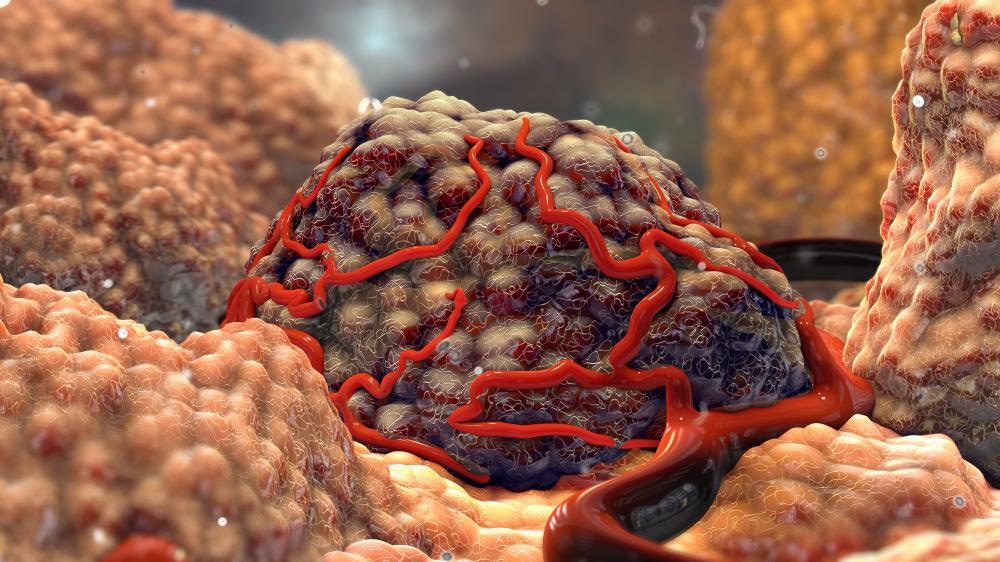A group of researchers recently published a paper in the journal ACS Applied Materials and Interfaces that demonstrated the feasibility of carbon-based hybrid nanogels in imaging-guided tumor phototherapy.

Study: Programmed Stimuli-Responsive Carbon Dot-Nanogel Hybrids for Imaging-Guided Enhanced Tumor Phototherapy. Image Credit: Nathan Devery/Shutterstock.com
Background
Nanoparticles (NPs) with both therapeutic and imaging functions are referred to as theranostic agents, which are used for early treatment, staging, diagnosis, and screening of cancer. These agents can increase the precision of treatment, overcome tumor heterogeneity, and decrease side effects.
However, clinical applications and translation of theranostic agents are hampered by their poor tumor targetability and sophisticated fabrication process, which necessitated the development of improved controllable methods to fabricate theranostic agents that can effectively overcome the biological barriers.
Carbon dots (CDs) have gained prominence among carbon family materials owing to their rapid renal metabolism, excellent biocompatibility, and tunable optical properties. Specifically, uniquely designed CDs can meet the crucial requirements of cancer treatment and diagnosis such as near-infrared (NIR)/red fluorescence emissions, generation of heat and/or reactive oxygen species (ROS), and sensitive photoacoustic (PA) response, when they are triggered by external stimulations.
Significant efforts were devoted to the development of multifunctional CDs to achieve imaging-guided cancer therapy using CD-based nanomaterials. However, the small size of CDs, often less than 10 nm, prevents adequate accumulation of the agents at tumor sites, leading to poor theranostic outcomes.
The large size of CD nanocomposites, on the other hand, can lead to unsatisfactory cell internalization and tumor penetration, as well as safety concerns owing to poor degradation.
Stimuli-responsive nanomaterials can potentially overcome these issues as their performance can be controllably transformed by exposing them to the exogenous physical stimuli and/or endogenous tumor microenvironment (TME).
Among the stimuli-responsive nanomaterials, nanogels are more attractive owing to their sensitive responsiveness toward a range of physicochemical stimulations, minimized immunological responses, and proper particle size that supports the prolonged circulation of blood.
In fine-designed nanogels, multistimuli-responsive properties can be endowed through the introduction of proper reaction monomers.
In this study, researchers synthesized CD-nanogel hybrids, referred to as poly (N-isopropylacrylamide)-carbon dots (PNIPAM-CDs) with programmed stimuli-responsiveness through an in situ composition of copolymers containing stimuli-responsive units and PNIPAM, and versatile CDs.
Researchers also investigated the effectiveness of the hybrid nanogels in balancing the contradiction between enhanced tumor penetration and accumulation and facilitating efficient cell internalization.
The Study
Polyethyleneimine (PEI), glutathione (GSH), sulfobetaine methacrylate (SBMA), N-Isopropylacrylamide (NIPAM), N, N′-bis (acryloyl) cystamine (BAC), sodium dodecyl sulfate (SDS), N-methylallylamine (MAA), and potassium bisulfite (KBS) solution were the starting materials for the study.
About 1.5 g of PEI and 2.5 g of GSH were mixed with 75 mL of formamide and thoroughly dissolved. Subsequently, the mixture was placed in an air oven for 4 h at 160 oC, and the resulting viscous dark-green solution was cooled naturally to room temperature.
The crude product was purified by initially diluting it with 200 mL of water and then filtering with a 0.22 μm membrane filter, and finally dialyzing against deionized water for 1 week. Eventually, the purified CDs were obtained a dark-green powder through lyophilization.
A total of 5 mg of SDS, 17 mg of MAA, 252 mg of NIPAM, 13 mg of BAC, and 13 mg of BAC were dissolved in a three-necked flask containing water. Subsequently, 25 mg of CDs and 13 mg of KBS were dissolved in 1 mL of water, and the mixture was slowly added to the three-necked flask through a two-path syringe pump.
The three-necked flask was then placed in a water bath under nitrogen protection for 4.5 h at 75 oC. After the mixture was dialyzed, it was cooled to room temperature for 1 week against water. Eventually, the PNIAPM-CDs were obtained as a green powder through lyophilization.
Hitachi F-4600 spectrophotometer, PERSEE T10CS UV−vis spectrophotometer, AXIS ULTRA DLD XPS spectrometer, Nicolet 6700 FT-IR spectrometer, Tecnai F20, and Zetasizer Nano ZS were employed to characterize the synthesized samples.
The photothermal property of the synthesized PNIPAM-CDs was evaluated through a thermal infrared imager.
Cell culture, animal experiments, and histology staining were performed to evaluate the effectiveness of PNIPAM-CDs against tumor cells in animals and assess the systemic toxicity of PNIPAM-CDs after their application in the animal body.
Observations
PNIPAM-CDs were successfully synthesized as a programmed multistimuli responsive theranostic nanoplatform. The synthesized hybrid nanogels were applied successfully to the dual-modal PA and FL imaging-guided tumor synergistic photodynamic therapy (PDT) and photothermal therapy (PTT) in vivo and in vitro.
The PNIPAM-CDs demonstrated enhanced accumulation at the tumor site due to their excellent biocompatibility and larger particle size.
Rapid body clearance, efficient cellular internalization, and deep penetration in tumor tissue were also achieved due to the multistimuli responsiveness of hybrid nanogels.
The multistimuli responsiveness included GSH-activated degradation, temperature-dependent hydrophobicity and hydrophilicity transition, pH-responsive charge reversal, and light-triggered size reduction. These performances led to exceptional therapeutic outcomes with fewer safety concerns and minimized adverse effects.
Significance of the Study
Taken together, the findings of this study demonstrated an innovative strategy to synthesize nanotheranostic agents using only a single functional component, which can enhance the preparation controllability and simplify the preparation process.
Additionally, the study showed the effectiveness of hybrid nanogels in overcoming several biological barriers associated with the transportation of theranostic agents into tumor cells, which increased their overall efficacy and decreased side effects.
Reference
Sun, S., Chen, Q., Li, Z. et al. (2022) Programmed Stimuli-Responsive Carbon Dot-Nanogel Hybrids for Imaging-Guided Enhanced Tumor Phototherapy. ACS Applied Materials and Interfaces https://pubs.acs.org/doi/10.1021/acsami.2c00174
Disclaimer: The views expressed here are those of the author expressed in their private capacity and do not necessarily represent the views of AZoM.com Limited T/A AZoNetwork the owner and operator of this website. This disclaimer forms part of the Terms and conditions of use of this website.